By TREVOR HOGG
By TREVOR HOGG
Images courtesy of Disney Enterprises.
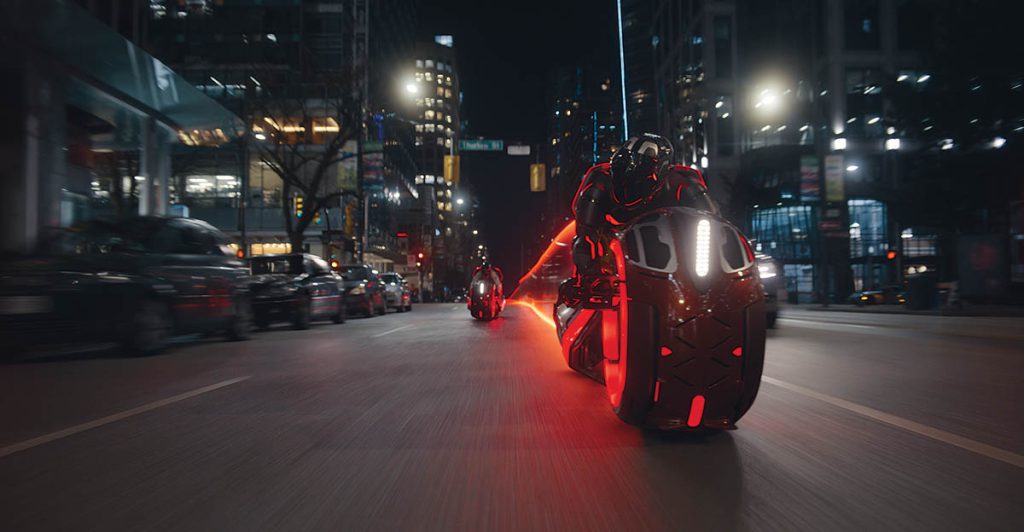
As much as Tron was prescient in regards to the technological and societal impact of computers, the growing debate over the application and ramification of artificial intelligence has worked itself into the video game-inspired universe conceived by Steven Lisberger with the release of Tron: Ares. Whereas Tron and Tron: Legacy essentially took place within the digital realm, the third installment, directed by Joachim Rønning, goes beyond the motherboard as an advanced AI program known as Ares (Jared Leto) embarks on a dangerous mission in the real world.
“The core of our film is this contrast between the Real World and Grid World, which has been established within the first two Tron films,” notes VFX Supervisor David Seager. “The big challenge for us was, how do you bring the Grid into the real world in a believable fashion? There is a lot of embellishment that could be made when you’re inside the Grid because you can say, ‘This is inside of the computer, so Grid things can happen.’ But if you did some of those exact same things in the photography you shot in the real world, it would begin to break the illusion. Joachim Rønning drove it from the start by embracing, ‘What does a Light Cycle look like in the real world? How does it behave?’ There were all of these different things we had to embrace and answer for ourselves to find a language that first and foremost supports the story, but, also, the more believable the visual is, the more people are going to buy into the story.”
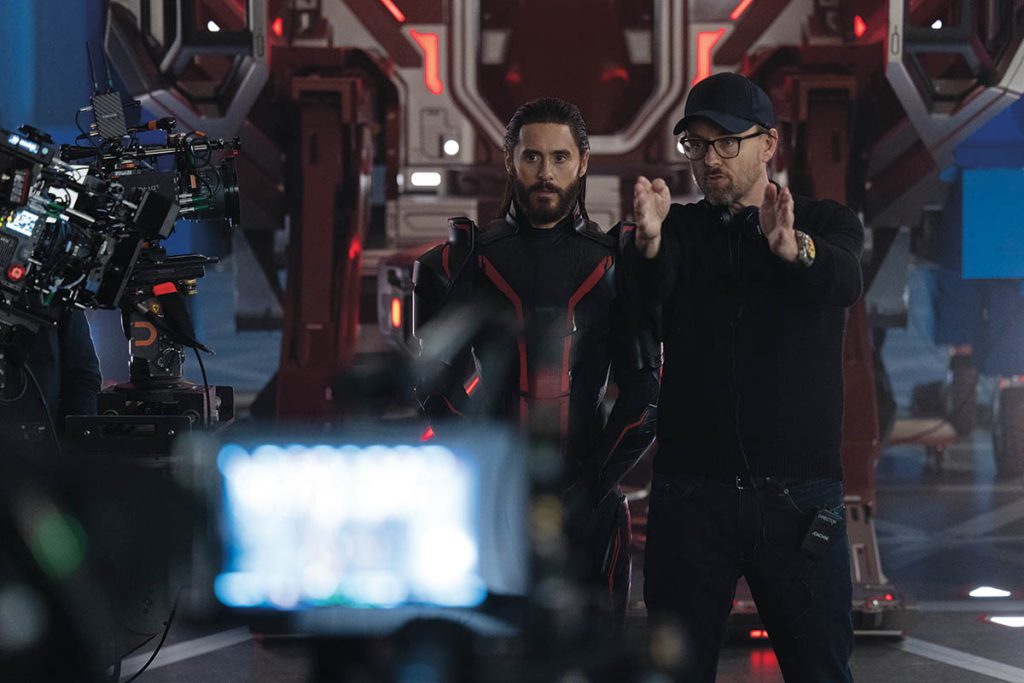
Light-emitting vehicles, weapons and suits are part of the visual language for Tron. “With the majority of our film being in the real world, we embraced shooting as much as possible in the real world,” Seager states. “The Light Cycles are the best example of that. You can sit there and go, ‘You want to shoot in the real world. Then go with a camera, shoot an empty road and imagine what’s happening.’ Or, what we decided to do, which is to say, ‘We’re going to have proxy bikes that represent Light Cycles.’ Our entire team worked together to find these electric Harley-Davidson bikes that were modified to have the same wheelbase of a Light Cycle and had the stunt team driving through the streets doing the action. I find you get that added reality of the real physics of the bike having to change lanes, pulling in front of a car and the camera car following. The speed is different, so the camera operator has to correct and keep his eye on the camera. All these million decisions go together to make a shot that looks like a motorcycle driving down a street. Then, our job is to go back, and over the top of that proxy we put our Light Cycle. We worked with the lighting department and put a bunch of LED bricks on bikes to have them emit light. Even the stunt riders’ safety suits had light lines. Our hope there is you might get some happy accidents. The fact that we had a real bike reflecting where it needed to reflect and casting that light where it needed to go was a guide. Were there times when we wanted to deviate from that motion? Absolutely! However, the number of wins we have far outweighed those times we had to go in there and paint some light out.”
Among over 2,000 visual effects shots produced by primary vendor ILM, as well as Distillery VFX, Image Engine, GMUNK, Lola VFX and Opsis, is the signature action sequence where a pursuing police car gets sliced in half by a Light Ribbon generated by a Light Cycle. “You see what they filmed practically and notice what you need to do,” remarks Vincent Papaix, VFX Supervisor at ILM. “There is postvis happening. We need to make it look photoreal, and for the way we see a Light Ribbon, it’s in its name. It’s light and Ribbon, so we make it an indestructible piece of glass emitting energy that can cut things. The special effects team had a precut police car, pulled it with two wires and then separated it. What we enhanced in CG was the Light Ribbon, but also the sparks, the piece of the engine falling down, dust and smoke. We also had to have a tight match to the police car because of all the interactive light and reflections that go in there. We could have done full CG, however, because of my compositing background, I am a big fan of trying to preserve the photography. It was meticulous work from the 3D and 2D departments to blend the plate and CG that was going on top to make it seamless.”
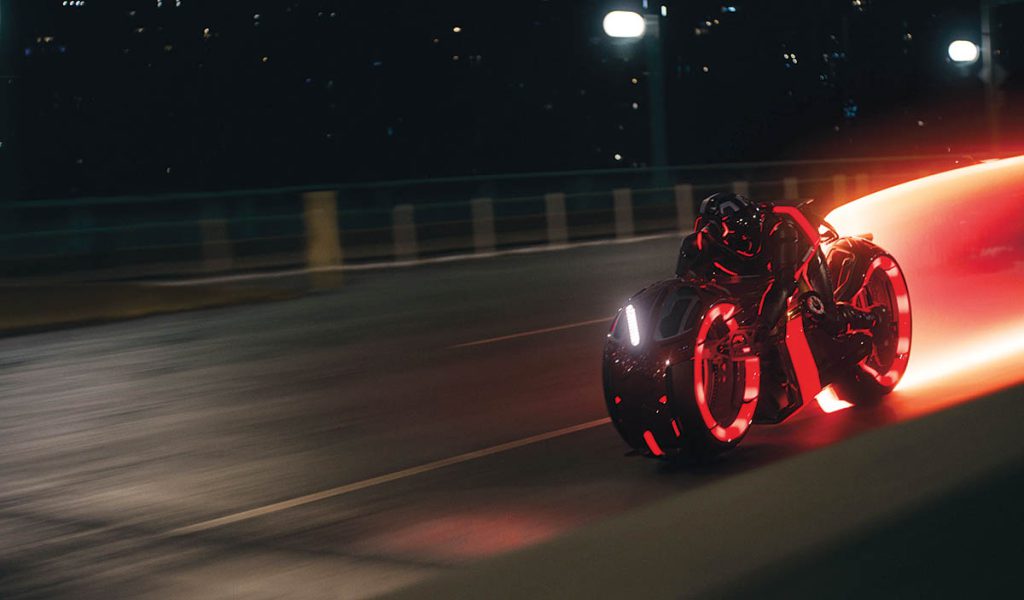
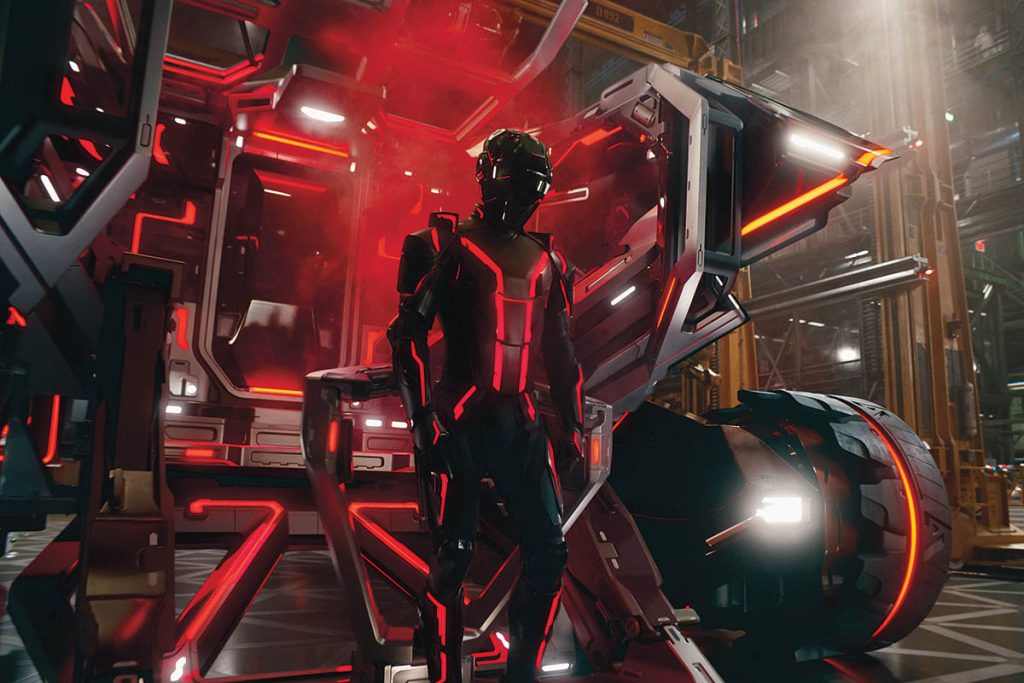
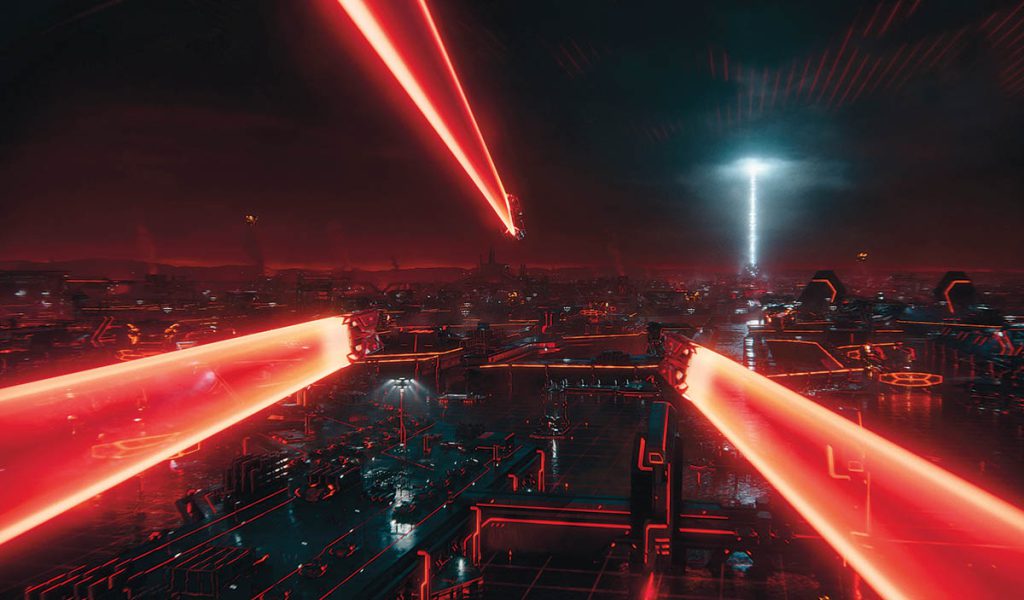
Appearing in the sky is the Recognizer. “What we did in order to make the Recognizer believable in the real world was to add a lot of details, like screws and an engine that was referenced from a rocket ship,” Papaix states. “It’s still the design of Tron, but with the technology of our real world to make sure this can fly in a believable way.” A larger issue was the environmental integration. “We used Burrard Street, one of the biggest avenues in Vancouver, but when we put the Recognizer in the scene, it would be in-between buildings when it’s supposed to move through the street. That’s because in the story the Recognizer is chasing a character, so it needs to be not just over the city but be able to go through the city. In order to do this, sometimes we had to widen the street, which was quite a challenge.” Vancouver is known for rain. Papaix says, “All of our photography work had wet ground, and wet means it reflects a lot. On set, they put a lot of LED tubes where the action was supposed to be. Most of the time it worked great. We built an entire Vancouver in CG and had a couple of blocks at the ground level that were a photoreal full CG asset. We put in the effort to have a CG replica of the real photography, so we were able to render our CG version of the city to patch things as needed or integrate things because the action got moved.”
Animators had to act like cinematographers. “At the end of the third act, there is a dogfight between some Tron Light Jets and a F-35, and besides animating the vehicles, we also animated all of the cameras,” states Mike Beaulieu, Animation Supervisor at ILM. “We looked at aerial footage of different films or documentaries, and made a list of what kinds of lenses we usually use when we’re shooting stuff like that. It also gets creative because our director has a sensibility for what kind of lenses he prefers and what types of shots he likes to have. We can make adjustments there. We would animate everything in 3D space first and then we would go in with an eye of, ‘How would we film all of this stuff?’ We would cover it with different camera angles and see what angles looked most interesting, which ones tell the story the best and still have an energy to it without getting too flat; 200mm to 400mm lenses tend to flatten everything, so to have a sense of traveling through 3D space with lenses like that is tricky. You can have a jet flying at you going 300 miles per hour, but with a 400mm lens, when you’re that far away, it doesn’t look like it’s changing that much. We had to get creative by covering it with a 100mm lens so we can actually read some of that travel of the jet flying around.”
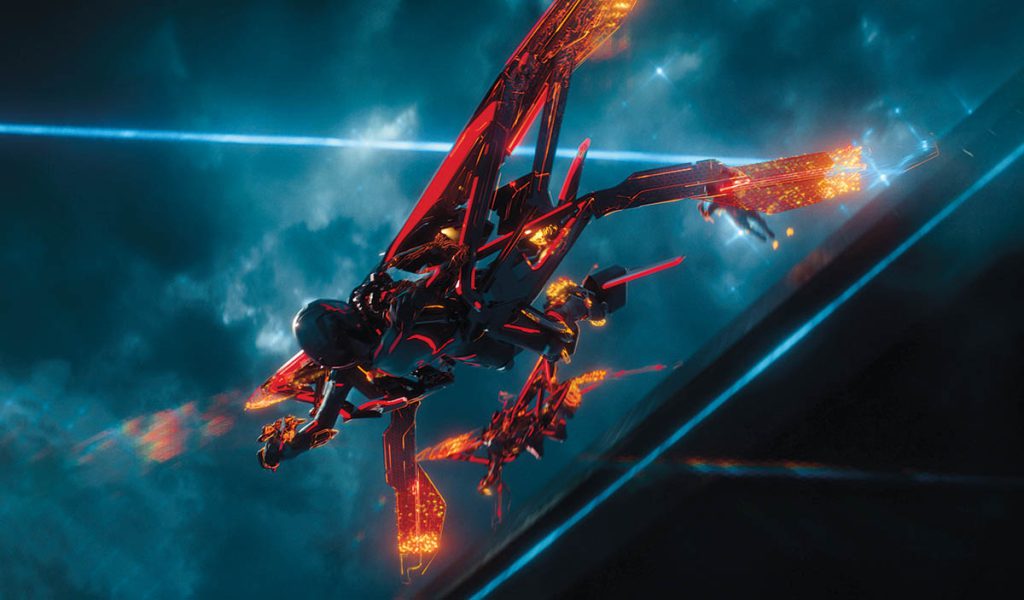
A new Identity Disc is introduced. “You get to read a little bit more of the animation of the triangle disc that Ares has as it’s flying through the air,” Beaulieu remarks. “Because of its shape, you don’t always register the revolutions that the circular disc is doing as it’s getting thrown. The triangular disc also had these little blades that come out on the ends, which adds to the silhouette. We had conversations about how the triangular discs should move and behave. Do they behave as you would expect in the computer program where they go on a perfectly straight line and hit things and rebound, like Captain America’s shield where it deflects off surfaces? Or do we play it more [as if ] they have to arc like a frisbee or boomerang? We ended up falling into a realm where we did a bit of both. Whatever felt best for the shot. If it needed to be something fast and have a big impact then something that was straight would feel better. But in the wider shots we had to put an arc on some of the discs to differentiate them. There is a sequence when we have these ENCOM soldiers flooding the plaza and they’re throwing discs. There are 15, 20 or 35 discs flying around in the shot, so to make them all read, we had to vary what they were doing. Some of them are flying straight and others are on a bit of an arc.”
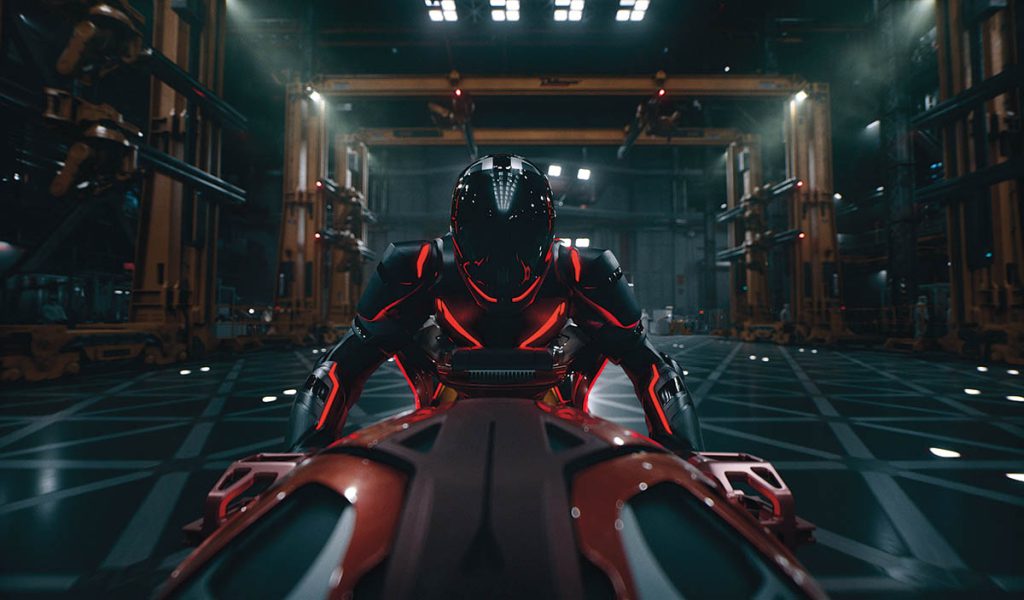
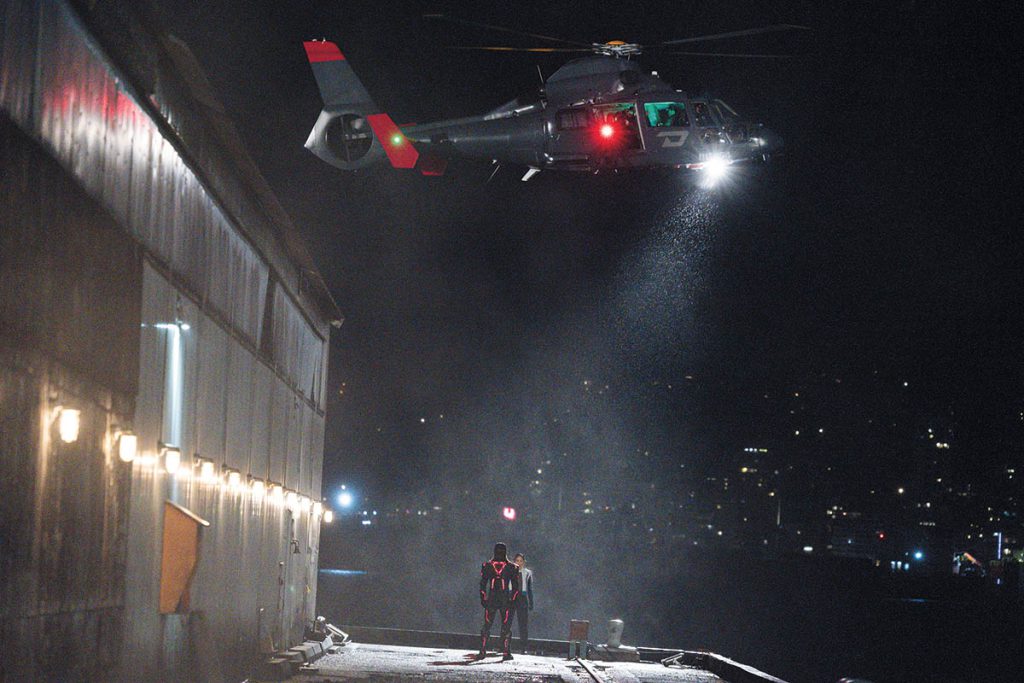
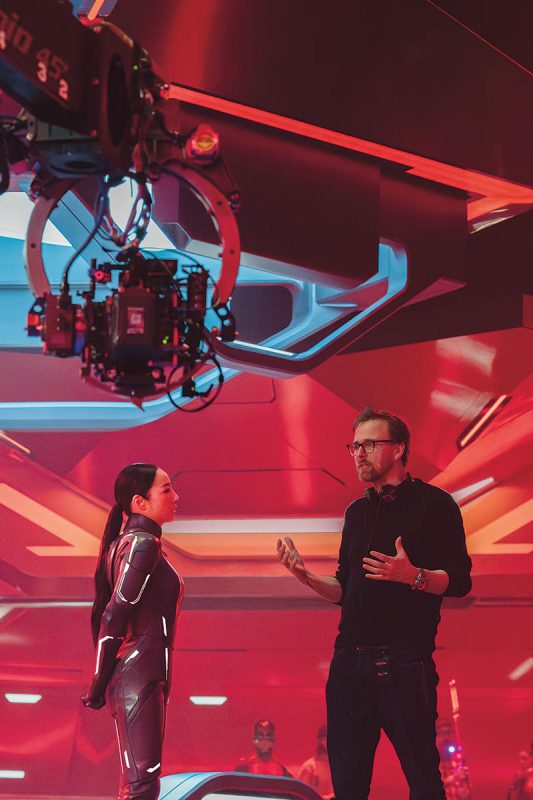
Light Ribbons surpass lightsabers in complexity. “There’s something that nobody realizes, which is the history of Light Ribbons is tricky,” notes Jhon Alvarado, Animation Supervisor at ILM. “Basically, for every shot, you have to animate Light Ribbons four shots before it.” Performances had to be altered because of the Light Ribbons. “If you play that shot a little longer, they’ll be going straight through a Light Ribbon. We had to change the motion to make them get past it. There are happy accidents that come about where an actor leans over a tiny bit, and there’s nothing there to tell her to do that, but it works perfectly with her getting out of the way of the Light Ribbons. Then Jeff [Capogreco, VFX Supervisor] adds a reflection of the Light Ribbons reflecting on the environment and face, and all of a sudden you go, ‘Those Light Ribbons were there the whole time. How did they do that?’” The Light Ribbons had to be produced quickly and efficiently. Alvarado says, “At the beginning it was a hard, slow process to get the Light Ribbons generated, so we took a lot of technology and worked with our pipeline and R&D to determine how we get this in Maya so the animators are able to generate Light Ribbons in real-time or quickly whenever there is a change. For example, if we have to do 300 or 500 frames of history, we don’t want to be there waiting for half an hour as the Ribbons generate. We want to see it straightaway. There was a lot of work that was done to accommodate for these changes that happen in the filmmaking process.”
Ares originates in the Dillinger Grid, which has a red color palette and resembles an industrial wasteland. “The environment itself is loosely interpreted as a giant motherboard surrounded by voxelated water,” states Jeff Capogreco, VFX Supervisor at ILM. “There is a whole sequence where Ares and Eve are riding a Skimmer, a floating motorcycle that causes the water to create a giant rooster tail of bioluminescence and water spray. We did this whole deep dive of finding a bunch of clips of rooster tails shot at different times of day and angles, and we had the shading folks go in and light it, match it and validate it. Once we had that in the can, we started to interject what we were going to be doing. The other neat thing is, as you’re going along the water you start to realize that the water is actually a bunch of grids. Imagine you’re in fairly calm water where every 20-by-20 meters, there is a red border that outlines an area. One neat component is, as the Skimmer passes through these gates, it charges the rooster tail. You get these bursts of beautiful bioluminescence energy that illuminates the environment. We wanted to give it a visual feast.”
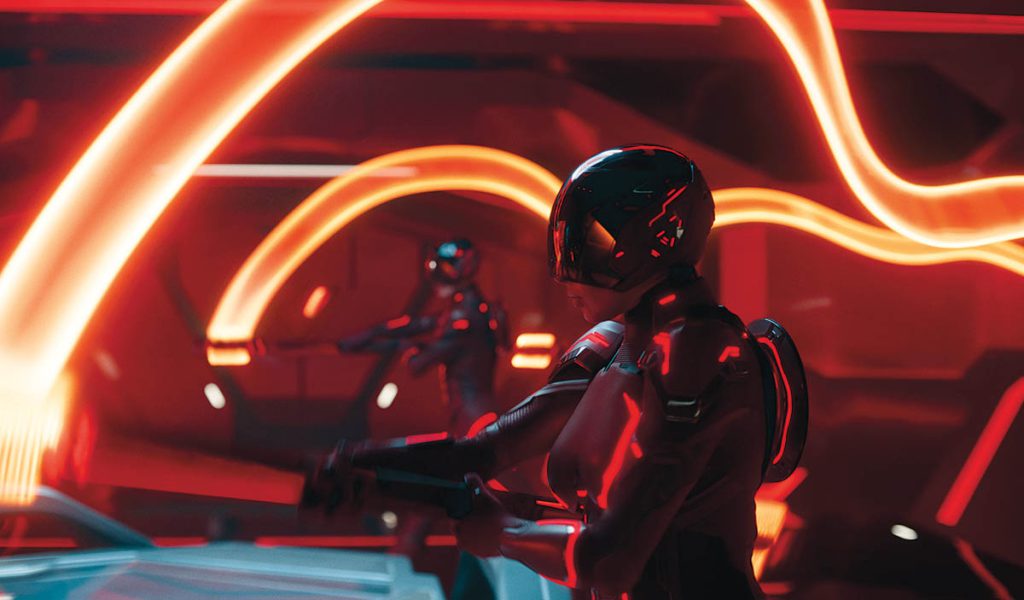
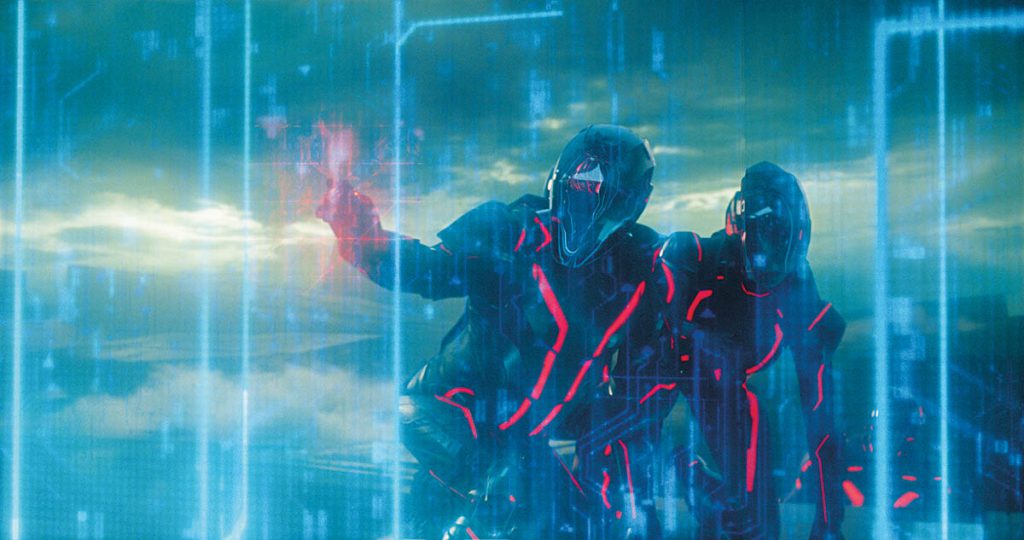
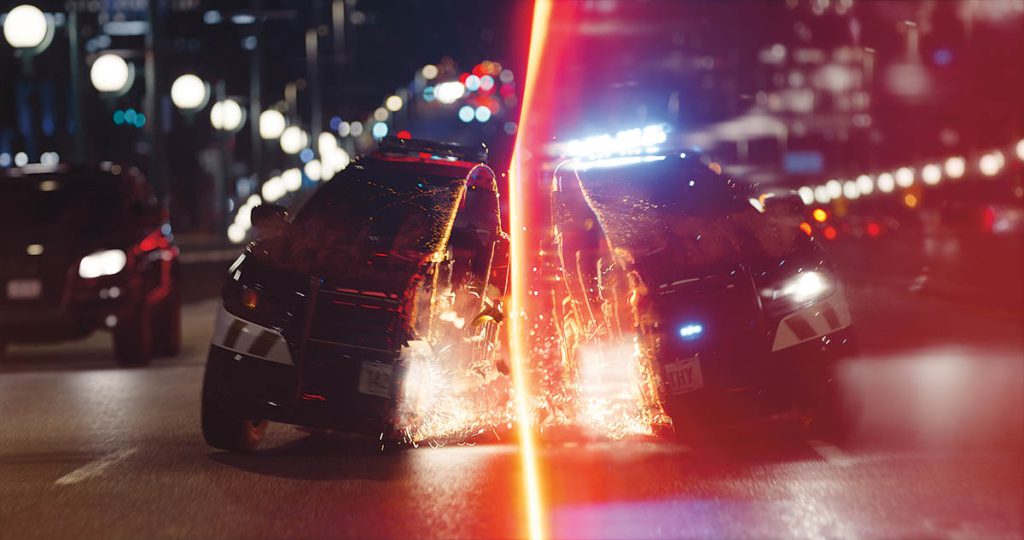
“Another department that we collaborated with was environments because you can imagine the Dillinger Grid being huge,” Alvarado remarks. “The Skimmer is traveling 150 miles an hour. We had to find ways for us to change and add things in animation that environments then used to Tron-ify the world and still feel in that environment. Another thing that we [addressed] was how do we create life in this Dillinger Grid? We have people and objects flying, and to go to every shot in animation and add that to this huge world would have been time-consuming. I spent time working with the environments artists to create a Dillinger Grid library of life. Then, environments procedurally put it within this grid, and we see it in shot. If something calls out in the shot then we can go in and change it. But most of the time we were like, ‘That’s enough.’ Things like that allow us to use the departments, collaboration and technology to help us get the best out of it rather than brute force our way into it all the time.”
When it comes to figuring out how Ares makes the transition from the Grid World into the Real World, a current technology was utilized. “They didn’t want that sharp contrast, like computer and real,” Capogreco reveals. “You can imagine these conversations. There was at least a year’s worth of R&D and trying to figure out, how do you bring a program into the real world? We leveraged the idea of 3D printing technology. What you will see are things that are born out of Jig. If you know anything about 3D printing, you get these pieces that support the model inside, and what you will see visually are lasers effectively creating these structures, and inside the structures are printed human beings or programs or vehicles that are then born into the real world. It’s beautiful. Lots of deep contrast, sparks and lasers. It’s science fiction at its best.”
It is not always about being revolutionary. Capogreco observes, “It’s finding ways to get the most out of what we have as opposed to reinventing something. With present-day computer technology, we’re not having to rewrite renderings. We’ve got Pixar’s RenderMan, which is phenomenal. It’s more about how can we maximize for performances as well as working with Jhon and animation to make sure we’re obeying physics – and not changing things too quickly or doing things that are going to make simulations go off the rails. It has been a great process on this show.”